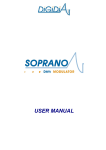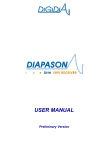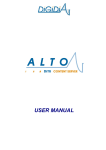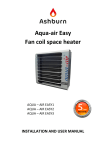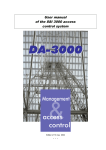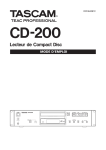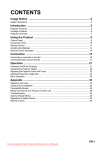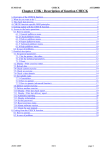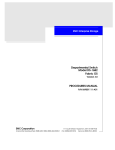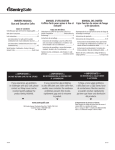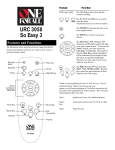Download EasyDAB - Integrated DMB/DAB System - User manual
Transcript
USER MANUAL EasyDAB User Manual History of modification of this document Reference: DT00009 Revision Date Product version Modified sections Comments A 26/06/06 V1.00 - Creation WARNING This document contains preliminary information about EasyDAB DIGIDIA reserves the right to make changes at any time without prior notice in order to improve design and supply the best possible product. This document includes some confidential information. It can not be copied, otherwise reproduced, translated into another language or transmitted without prior written authorisation from DIGIDIA. TABLE OF CONTENTS 1INTRODUCTION................................................................................................................ 4 2PRODUCT PRESENTATION............................................................................................ 5 3FEATURES AND PERFORMANCES................................................................................ 6 3.1Generalities................................................................................................................................ 3.1Generalities................................................................................................................................ 6 3.2Power requirements................................................................................................................... 7 requirements...................................................................................................................7 3.3Safety requirements.................................................................................................................. requirements.................................................................................................................. 8 3.4EMC compliance........................................................................................................................ compliance........................................................................................................................ 8 3.5Transport requirements............................................................................................................. requirements............................................................................................................. 8 3.6Storage requirements................................................................................................................ requirements................................................................................................................ 8 3.7Environmental requirements ..................................................................................................... 8 3.8Mechanical Characteristics........................................................................................................ Characteristics........................................................................................................ 9 4GETTING STARTED....................................................................................................... 10 4.1Unpacking the EasyDAB rack................................................................................................. rack................................................................................................. 10 4.2First start up............................................................................................................................. up............................................................................................................................. 10 5MAINTENANCE............................................................................................................... 12 5.1Reading the log file.................................................................................................................. file.................................................................................................................. 12 5.2First level maintenance............................................................................................................ maintenance............................................................................................................ 12 6APPENDIX....................................................................................................................... 13 6.1Glossary................................................................................................................................... 6.1Glossary................................................................................................................................... 13 6.2References.............................................................................................................................. 6.2References.............................................................................................................................. 13 6.3Rear panel of EasyDAB .......................................................................................................... 14 6.4Control Software...................................................................................................................... Software...................................................................................................................... 16 6.5Warranty terms........................................................................................................................ terms........................................................................................................................ 16 6.6Instructions in case of return to factory................................................................................... factory................................................................................... 17 EasyDAB User Manual 1 INTRODUCTION This document is the user manual for the EasyDAB product. It provides general information about the EasyDAB product, and detailed performance characteristics. This user manual is divided into 6 sections where the user can find all the necessary information for the installation, the usual operation and the first level maintenance of it. This part gives a general presentation of this manual. Section 1 – Introduction Section 2 – Product presentation This part describes EasyDAB and its applications. Section 3 – Features and performances This part provides detailed information about interfaces and operation of the EasyDAB This part provides information about installation, Section 4 – Getting started configuration and normal operation of the EasyDAB This part explains how to make first level maintenance. Section 5 – Maintenance The appendixes give additional detailed information Section 6 – Appendix about the EasyDAB and its operation. Page 4/20 EasyDAB User Manual 2 PRODUCT PRESENTATION EasyDAB belongs to the DMB/DAB product line developed by DIGIDIA. The EasyDAB DMB/DAB Integrated System provided by DIGIDIA is fully compliant to the DMB/DAB standard (Eureka147) and is specially designed for commercial networks. This device performs the DAB audio encoding process with the insertion of PAD (DLS and PAD MOT) and the multiplexing of an ETI (NI, G703) or ETI(NA, G704) transport stream. EasyDAB is also able to encode in real-time all standardized DAB data applications (Slide Show, Broadcast Web Site or IP Tunnelling) and video in both DMB (Digital Multimedia Broadcasting) or EPM (Enhanced Packet Mode) formats. All setup, control and monitoring of the EasyDAB DMB/DAB Integrated System is done through an Ethernet link and using Internet Explorer running on any kind of computer with friendly HTML pages. Alarms can also be controlled and monitored by any standard SNMP managers (standard MIB). EasyDAB includes a PC board packaged in a 2U 19" rack and gives to the user, guarantees of reliability and robustness against severe environment including EMC constraints. Page 5/20 EasyDAB User Manual 3 FEATURES AND PERFORMANCES 3.1 Generalities EasyDAB DMB/DAB Integrated System depicted in figure 1 provides: • DAB multiplexing according to the ETI standards (see References); • ETI(NI, G703) or ETI(NA, G704) output formats; • External GPS receiver as an option; • One audio input (Digital or Analog); • Multiple configuration management for operations; • SNMP alarms reporting and control for operations; • Text message insertion (DLS: Dynamic Label Segment); • MOT PAD data insertion as an option (MOT Slide Show, MOT Broadcast Web Site); • User-friendly HTTP interface for configuration management and network supervision; • Unlimited data application management as an option (MOT Slide Show, MOT Broadcast Web Site, IP Tunnelling...); • Video program insertion as an option (both DMB and DAB-EPM supported); • User-friendly data application edition and API for automated data insertion as an option; • Up to 3 additional audio inputs as an option (Analog only); Audio Text Data PAD PAD 1: Block Audio Encoding Figure PAD MOT PAD Audio Encoding DLS PAD PAD Audio Encoding DLS PADMOT PAD DLS MOT Audio Encoding DLS MOT diagram. FIC ETI NI G703 Ensemble Data NPAD Inserter MOT Video Packet Mode MSC Or Multiplexing ETI NA G704 IP Tunneling TIST T-DMB Video Inserter Web Server SNMP Agent MIB Ethernet DAB COMPOSER DAB/DMB System Manager System Setup, Control & Monitoring HTTP interface Figure 1: EasyDAB functional diagram. Page 6/20 EasyDAB User Manual GPS GPS GPS Rx ETI (NI or NA) DMB/DAB Transmitter Audio Text Data Tx Site 1 EasyDAB DMB/DAB Integrated System ETI (NI or NA) Distribution Network F1 SFN GPS Tx Site 2 F1 ETI (NI or NA) Video Network DMB/DAB Transmitter Ethernet WAN DMB/DAB System Manager Setup, Control & Monitoring HTTP interface Figure 2: Typical system implementation. Typical DMB/DAB network setup is depicted in figure 2. The EasyDAB DMB/DAB Integrated System is providing DMB/DAB encoding of audio, text, data and video and for a SFN network based on multiple DMB/DAB Transmitters. 3.2 Power requirements 3.2.1 Main voltage specifications The DIGIDIA equipment can be operated within the following ranges: Input voltage 85 to 264 volts Frequency 47 to 63 Hz The DIGIDIA equipment is delivered with a redundant power supply. Assure that both power supplies are connected. In case of unplugged power supply, the equipment power led on front panel is lightening red and the power supply supervisor rings. WARNING Equipment must be switch off and main line supply disconnected to network before all open operation or only by qualified staff. Page 7/20 EasyDAB User Manual 3.3 Safety requirements Equipment connected to the mains by plug on TN or TT power systems, socket-outlet shall be installed near the equipment and shall be easily accessible. Class I equipment (only connected to a socket-outlet with a protective earth connection). Installation category II. Pollution degree 2. The EasyDAB equipment must be connected to earth in accordance to CEI364 (NFC15-100). 3.4 EMC compliance The EasyDAB equipment complies with the European Directives for Electromagnetic Compatibility (EMC 89/336/EEC). The equipment complies with the EN55022-B class and the EN50082-1 standards. EMC characteristics can be guaranteed only if input / output cables with appropriate shielding are used. It is necessary to establish a direct short connection between the earth connection point of the rack and any grounding point available on the bay or chassis in which the system is installed in order to meet EMC constraints. 3.5 Transport requirements Use only the original packing for the transport of any equipment. WARNING The EasyDAB remains under guarantee only if this condition is met. 3.6 Storage requirements Recommended storage temperature Recommended relative humidity -20° C and +70° C. 10 to 80 % at 50°C 3.7 Environmental requirements 3.7.1 Temperature Correct operation of the EasyDAB equipment is insured in an ambient temperature between the following limits: + 0°C and + 50°C. Power dissipation of the product with all options installed does not exceed 20 W. Page 8/20 EasyDAB User Manual 3.7.2 Cooling Multiple internal fans cool EasyDAB in its 2RU configuration. The airflow is entering the unit through the front panel and ejected through the rear panel. 3.7.3 Altitude The EasyDAB equipment can be used from sea level up to 4000 m over sea level. 3.8 Mechanical Characteristics 3.8.1 • • Weight: 15 kg Dimensions (W x D x H): 483 mm (19’’) x 640 mm x 88,5 mm (2RU) 3.8.2 • • Weight and dimensions (EasyDAB only) Weight and dimensions (EasyDAB in its original packing, ready for shipment) Weight: 20 kg Dimensions (W x D x H): 800 mm * 900 mm * 400 mm Page 9/20 EasyDAB User Manual 4 GETTING STARTED 4.1 Unpacking the EasyDAB rack 1. Check the packing against transport damage. If it is the case, please contact the carrier immediately. 2. Be careful while unpacking, the equipment may be heavy and must be handled with care. 3. Keep the original packing for further transport. 4. Check the equipment against transport damage. 5. Check if the expected electric cable and the user manual are provided. 4.2 First start up The equipment must be installed in a 19 inch bay. Several holes are available on the front panel to tighten the rack inside the cabinet, as presented in the following diagram: 8mm 6.8mm 11mm WARNING Service work described in this paragraph must be carried out by trained staff. Because of the weight of the rack, mounting it into a cabinet requires the rack to be supported by rails and not by the front panel only. 1. Install all necessary cables included the two audio cables (refer to 6.3.3). 2. Make sure the equipment is correctly grounded. 3. Make sure the air flow around the equipment permits an optimal cooling. (Do not obstruct the blower output). No other equipment should be installed directly under and above the EasyDAB equipment. 4. Connect the power supply Page 10/20 EasyDAB User Manual WARNING To prevent damage to the equipment, check the main voltage, current and frequency available which must be in the range of DIGIDIA specifications. 1. Switch your device on WARNING EasyDAB can be controlled using a web browser installed on a computer. An on-line help is available for each menu. The default settings are the following : • IP address: 10.64.0.1 • Subnet Mask: 255.240.0.0 • Gateway : 10.64.0.1 • Equipment name : EasyDABxxx; xxx corresponds to the EasyDAB serial number • Equipment comment : NO COMMENT • User/Password : public/public (level 1); level 1 is the less restricted access level. • LogFile : no event Page 11/20 EasyDAB User Manual 5 MAINTENANCE 5.1 Reading the log file EasyDAB includes a log file in which the 256 last events are stored. Use the web browser to read it. 5.2 First level maintenance Because of the digital technology used in the DIGIDIA equipment, the first level maintenance is restricted to an exchange of the whole equipment. WARNING Make sure the operator has an easy and safe access to the equipment. 5.2.1 Rack replacement See the following « Uninstalling the equipment » section. 5.2.2 Uninstalling the equipment WARNING 1. 2. 3. 4. 5. 6. 7. Make sure the operator has an easy and safe access to the equipment. Switch the equipment off, and remove its corresponding main cable. Remove all other cables. Remove all necessary screws, including its back plane screw. Extract the unit from its housing by pulling out the unit by its front panel handles. In case the equipment is replaced by a spare one, see « First start-up » section. Check that the place is still safe for the operation of the rest of the equipment in the bay. Page 12/20 EasyDAB User Manual 6 APPENDIX 6.1 Glossary BWS DAB DLS DMB EPM ETI GPS HTTP MIB MOT PAD SFN SNMP TCP / IP : Broadcast Web Site : Digital Audio Broadcasting : Dynamic Label Segment : Digital Multimedia Broadcasting : Enhanced Packet Mode : Ensemble Transport Interface : Global Positioning System : Hyper Text Tranfer Protocol : Management Information Base : Multimedia Object Transfer : Program Associated Data : Single Frequency Network : Simple Network Management Protocol : Internet Suite of Protocols 6.2 References [1] TS 102 427 Digital Audio Broadcasting (DAB); Data Broadcasting - MPEG-2 TS streaming [2] TS 102 428 Digital Audio Broadcasting (DAB); DMB video service; User Application Specification [3] TS 101 759 Digital Audio Broadcasting (DAB); DAB Data Broadcasting Transparent Data Channel [4] TR 101 497 Digital Audio Broadcasting (DAB); Rules of Operation for the Multimedia Object Transfer Protocol [5] TS 101 499 Digital Audio Broadcasting (DAB); MOT Slide Show; User Application Specification [6] EN 300 401 Digital Audio Broadcasting (DAB); DAB to mobile, portable and fixed receivers [7] ES 201 735 Digital Audio Broadcasting (DAB); Internet Protocol Datagram Tunnelling [8] TS 101 498-2 [9] TS 101 498-1 [10] EN 301 234 Digital Audio Broadcasting (DAB); Broadcast Web Site Application, Part 2: Basic Profile Specification Digital Audio Broadcasting (DAB); Broadcast Web Site Application, Part 1:User Application Specification Digital Audio Broadcasting (DAB); Multimedia Object Transfer (MOT) protocol [12] EN 550022-B Digital Audio Broadcasting (DAB); Distribution interfaces; Ensemble Transport Interface (ETI) Limits and methods of measurement of radio interferences characteristics of information technology equipment [13] EN 50082-1 Generic immunity standard – Part 1: Domestic commercial and light industry [11] ETS 300 799 Page 13/20 EasyDAB User Manual 6.3 Rear panel of EasyDAB 6.3.1 ETI input/output (5 & 6) BNC 75Ω connectors – HDB3 2,048Mbits/s ETI Input (6) is reserved for future use. 6.3.2 Synchro inputs (3 & 4) BNC 50Ω connectors These connectors are only used when the SFN (Single Frequency Network) option is required. 6.3.3 Audio inputs 'Synchro connector' (see below) to be connected to 'Audio Board Host Cable Connector 1' (DB9 female connector) Page 14/20 EasyDAB User Manual Digital input (402 – S/P I) is a RCA female connector, SP/DIF format Connectors 401 (IN & OUT), 402 (S/P O) and 403 (IN & OUT) are reserved for future use. 'Audio connector' (see below) to be connected to 'Audio Board Host Cable Connector 2' (DB25 female connector) Analog input (301 - IN1 & IN2) is a XLR female connector balanced, line. Analog inputs (302 – IN1 & IN2; 303 – IN1 & IN2 and 304 – IN1 & IN2) are RCA female connectors balanced, line and are only used when more than one input and up to four audio inputs options are required. Analog outputs (305 – OUT1 & OUT2; 306 – OUT1 & OUT2; 307 – OUT1 & OUT2 and 308 – OUT1 & OUT2) are reserved for future use. Page 15/20 EasyDAB User Manual 6.4 Control Software EasyDAB can be controlled using a web browser installed on a computer. System required: A computer with Windows (Millenium, NT, 2000 or XP) is required with Internet Explorer 6.0 (or higher) and JavaScript V1.5 installed. A network board have to be installed on this computer with the following settings : • IP address : 10.64.x.y with x and y different of the EasyDAB IP address (x ≠ 0 or y ≠ 1) in the case of the default IP address of EasyDAB (10.64.0.1) • Subnet Mask : 255.240.0.0 corresponding to the default subnet mask of EasyDAB. The connection between EasyDAB and the computer can be either made directly with a RJ45 crossed cable or through a standard Ethernet Hub for instance with a RJ45 direct cable. To check to the good network settings, ping the EasyDAB device in a DOS window (ping 10.64.0.1). 6.4.1 Control the EasyDAB To control EasyDAB : • • • Launch Internet Explorer, Fill in the address field : http://10.64.0.1 (10.64.0.1 corresponds to the default IP address of EasyDAB), Automatically, the welcome page appears. fill in User/Password fields with public/public (level 1 is the less restricted access level). For more information about the control software, read the on-line help. 6.5 Warranty terms 6.5.1 Standard product warranty This DIGIDIA product is warranted against defects in material and workmanship for a period of one year from date of shipment. During the warranty period, DIGIDIA will, at its option, either repair or replace products which prove to be defective, free-of charge. For warranty service or repair, this product must be returned to DIGIDIA France. Buyer shall prepay shipping charges to DIGIDIA and DIGIDIA shall pay shipping charges to return the product to buyer. Products returned for repair outside of the warranty period will be charged on a per unit basis. Per unit charges are established for each product repair as they arise. On request, a customer / supplier contract may be established for extending these warranty terms on a yearly basis. 6.5.2 Limitation of warranty The foregoing warranty shall not apply to defects resulting from improper or inadequate maintenance by Buyer, Buyer-supplied software or interfacing, unauthorized modification or misuse, operation outside of the environmental specifications for the product, or improper site preparation or maintenance. Page 16/20 EasyDAB User Manual 6.6 Instructions in case of return to factory In case you need to return your equipment to DIGIDIA for updating or maintenance, please use the following procedure: • Call the hot line at DIGIDIA before shipping your equipment, in order to check whether it is really necessary to return it. • The shipment back to DIGIDIA is organised by the customer and at his expense and DIGIDIA will organise and pay the return after repair to the customer’s company. If you are part of an EEC country, the shipment is at your expense until DIGIDIA’s premises. If you are outside EEC, the shipment is at your expense until RENNES SAINT-JACQUES airport (France). • During the guarantee period, the repair is free of charge. If your equipment is out of guarantee and if you have no maintenance contract (*), DIGIDIA will send you by fax a quotation for this repair that you have to acknowledge by sending the form back. • Always use the original packing in which the equipment had been delivered to you. • Do not return any documentation or cables (power cord or other). • Use the attached form to explain the reason of the return and, when necessary, the problems encountered. • Send the equipment to: DIGIDIA Customer Support Department Immeuble Orchis Les landes d'Apigné 35650 LE RHEU - France Tel: +33 (0)2 99 14 63 32 Fax: +33 (0)2 99 14 58 83 Email:[email protected] (*) If you want to set up a maintenance contract, please contact our sales department. Page 17/20 Model of report for return to factory From: Telephone: Company: Telefax: Under guarantee Other ( quotation will be submitted) Under a maintenance contract Type of system: EasyDAB Reason of return: Update Upgrade Maintenance Type of problem: Hardware Software Undefined EQUIPMENT SERIAL NUMBER FIRMWARE VERSION PC SOFTWARE NAME/VERSION EQUIPMENT SPECIFICITY (option, embedded boards, modem, etc.) PROBLEM SPECIFICATION (Front Panel state, Software menu, Error messages, etc.) Immeuble Orchis Les landes d'apigné -F-35560 LE RHEU Tel:+33 (0)2 99 14 63 32 - Fax:+33 (0)2 99 14 58 83 – Email: [email protected] ELECTROMAGNETIC COMPLIANCE STATEMENT (EEC directive 89/336 article 10) Manufacturer name: Address: DIGIDIA Immeuble Orchis Les landes d'apigné 35650 LE RHEU - FRANCE Equipment designation: DAB-EASY1; DAB-EASY2; DAB-EASY3; DAB-EASY4 M. OLIVIER Pascal, Manager Declare having the strong presumption that the above designated equipment complies with the essential EEC89/336 directive requirements, by application of the standards listed below: EN55022 Class A EN61000-3-3 EN55011 Group 1 Class A EN61000-6-2 EN61000-3-2 Class D Le Rheu, April 2006 Immeuble Orchis Les landes d'apigné -F-35560 LE RHEU Tel:+33 (0)2 99 14 63 32 - Fax:+33 (0)2 99 14 58 83 – Email: [email protected] SAFETY COMPLIANCE STATEMENT (EEC directive 73/23) Manufacturer name: Address: DIGIDIA Immeuble Orchis Les landes d'apigné 35650 LE RHEU - FRANCE Equipment designation: DAB-EASY1; DAB-EASY2; DAB-EASY3; DAB-EASY4 M. OLIVIER Pascal, Manager Declare having the strong presumption that the above designated equipment complies with the essential EEC73/23 directive requirements, by application of the standards listed below: NF EN 60950 NF EN 60215 Le Rheu, April 2006 Immeuble Orchis Les landes d'apigné -F-35560 LE RHEU Tel:+33 (0)2 99 14 63 32 - Fax:+33 (0)2 99 14 58 83 – Email: [email protected]




















